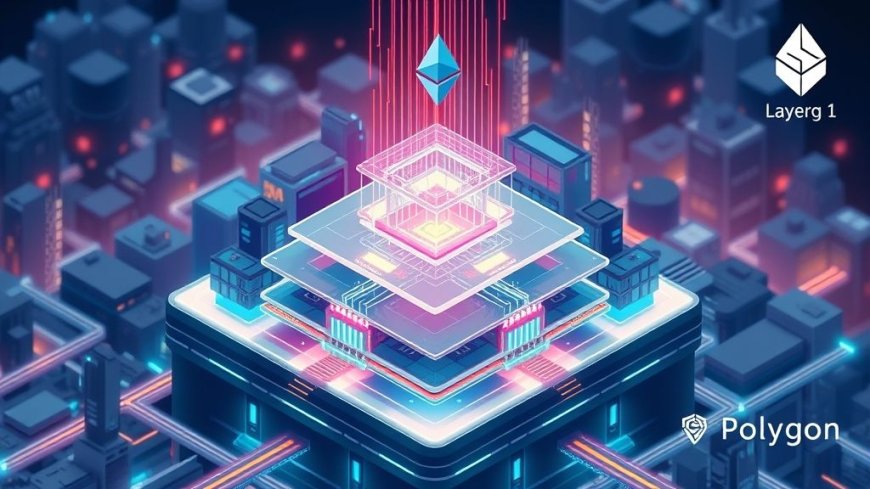How Layer 2 Blockchain Services Are Solving Web3’s Scalability Crisis
Discover how Layer 2 blockchain services are revolutionizing Web3 scalability. Learn about rollups, sidechains, and real-world use cases driving faster, cheaper, and more efficient decentralized applications in 2025.

The promise of Web3 a decentralized, user-owned internet powered by blockchain technology has generated immense excitement across industries. However, the road to mass adoption has been riddled with obstacles, the most pressing of which is scalability. As blockchain networks struggle with high gas fees, congested networks, and slow transaction speeds, the scalability problem has threatened to derail the decentralized revolution.
Enter Layer 2 blockchain services an innovative set of technologies and protocols designed to overcome the limitations of base Layer 1 blockchains like Ethereum and Bitcoin. These solutions offer a pathway to scale Web3 applications without compromising on decentralization or security.
The Scalability Trilemma: A Core Blockchain Dilemma
Before diving into Layer 2, its essential to understand the blockchain trilemmaa concept introduced by Ethereum co-founder Vitalik Buterin. This trilemma posits that blockchains must balance three crucial attributes:
-
Decentralization: Ensuring that no central authority controls the network.
-
Security: Safeguarding the network from attacks and manipulation.
-
Scalability: Processing a large number of transactions quickly and efficiently.
Most Layer 1 blockchains excel at two out of the three but falter at the third. For example, Ethereum prioritizes decentralization and security, but often suffers from congestion and high fees, limiting its scalability. Solving this trilemma without compromise is the goal of Layer 2 solutions.
What Are Layer 2 Blockchain Services?
Layer 2 refers to protocols or networks built on top of existing Layer 1 blockchains. They handle transactions off-chain or through alternative mechanisms, then periodically settle on the main chain to preserve security and decentralization.
Key Features of Layer 2:
-
Transaction batching: Processes many transactions off-chain and settles them as a single transaction on Layer 1.
-
Lower costs: Reduces gas fees significantly by minimizing on-chain data.
-
High throughput: Processes thousands of transactions per second (TPS) compared to Layer 1s limited capacity.
-
Interoperability: Seamlessly interacts with Layer 1 blockchains and decentralized apps (dApps).
Types of Layer 2 Scaling Solutions
Layer 2 scaling comes in several flavors, each with its own mechanisms and trade-offs. Heres a breakdown of the most prevalent Layer 2 technologies:
1. Rollups
Rollups bundle multiple transactions into one and post them to Layer 1 in a compressed form.
-
Optimistic Rollups: Assume transactions are valid unless challenged. Examples include Arbitrum and Optimism.
-
ZK-Rollups (Zero-Knowledge): Use cryptographic proofs to verify transaction validity. Examples: zkSync, StarkNet.
Pros:
-
Maintain Ethereum security
-
High scalability potential
-
Reduced transaction fees
2. State Channels
State channels allow users to transact off-chain, only settling on-chain when theyre done.
-
Examples: Lightning Network (Bitcoin), Raiden Network (Ethereum)
Pros:
-
Instant transactions
-
Near-zero fees
-
High privacy
Cons:
-
Limited to a fixed group of participants
-
Requires locking funds in smart contracts
3. Sidechains
Sidechains are independent blockchains running parallel to Layer 1 and connected via bridges.
-
Examples: Polygon PoS, xDai
Pros:
-
Customizable
-
Fast and cheap transactions
Cons:
-
Weaker security model compared to Layer 1
4. Validiums
Similar to ZK-Rollups but store data off-chain while still maintaining proof-based verification.
-
Example: StarkWares Validium
Pros:
-
High throughput
-
Privacy-friendly
Cons:
-
Slight compromise on decentralization
Why Layer 2 Is Crucial for Web3s Success
1. Unleashing Web3 DApps
Web3 applicationsNFT platforms, DeFi protocols, DAOs, and decentralized gamesrequire quick and cost-effective transactions to be viable. Without scalability, user experience deteriorates, deterring adoption.
Layer 2 makes these apps usable for real-world scenarios by:
-
Reducing gas fees (from dollars to cents or less)
-
Enabling fast transaction confirmation (within seconds)
-
Allowing micro-transactions, which are essential for gaming and social dApps
2. Empowering DeFi Growth
Decentralized finance has emerged as one of the most promising sectors in Web3, but Ethereums congestion has created bottlenecks. Layer 2 solutions enable:
-
Cross-chain asset transfers
-
Real-time trading with minimal slippage
-
Efficient yield farming and liquidity provision
Protocols like dYdX (built on StarkEx) and Uniswap on Optimism have shown the power of Layer 2 in scaling DeFi platforms.
3. Supporting NFT Ecosystems
The minting, trading, and transfer of NFTs can be expensive and slow on Layer 1. With Layer 2s:
-
Minting becomes near-instant and cost-effective
-
Artists and creators can reach a broader audience
-
Gaming assets can be easily transferred between players
Projects like Immutable X are pioneering Layer 2 solutions for NFTs.
4. Lowering Barriers to Entry
The cost and speed advantages of Layer 2 mean:
-
Users in developing regions can access Web3 without prohibitive fees
-
Developers can build without worrying about scalability limitations
-
Enterprises can deploy blockchain-based solutions at scale
Real-World Examples of Layer 2 Adoption
1. Arbitrum
-
Launched by Offchain Labs
-
Processes thousands of transactions per second
-
Hosts major dApps like GMX, Uniswap, and Aave
2. Optimism
-
Works with Ethereum via Optimistic Rollups
-
Powers major protocols like Synthetix, Velodrome
-
Introduced the Optimism Collective and OP token
3. zkSync Era
-
zk-Rollup technology with instant finality
-
Offers lower fees than traditional Ethereum
-
Actively used for NFT minting and DeFi protocols
4. Polygon (PoS and zkEVM)
-
Combines sidechain and rollup technologies
-
Polygon zkEVM brings full compatibility with Ethereum
-
Used by brands like Reddit, Starbucks, and Meta
Layer 2 and Ethereum 2.0: Competition or Complement?
Ethereums roadmap includes its own scaling plans via sharding and proof-of-stake (now live). But Ethereum 2.0 and Layer 2s are complementary, not competitors.
-
Ethereum 2.0 improves the base layer by increasing data availability.
-
Layer 2s focus on transaction execution and throughput.
Together, they create a modular blockchain architecture, where:
-
Layer 1 secures and settles
-
Layer 2 scales and accelerates
This synergy is critical for enabling the next generation of dApps and global-scale decentralized systems.
Challenges in Layer 2 Adoption
Despite the promise, Layer 2 solutions face several hurdles:
1. User Experience (UX)
-
Bridging assets between Layer 1 and Layer 2 is often complex
-
Wallets must support Layer 2 networks natively
-
Onboarding non-technical users remains a challenge
2. Fragmentation
-
Multiple Layer 2s create fragmented liquidity and user bases
-
Lack of standardization hampers seamless interoperability
3. Security Concerns
-
Some Layer 2s rely on centralized sequencers or bridges
-
Smart contract bugs in Layer 2 protocols can be exploited
4. Regulatory Clarity
-
Legal frameworks for multi-chain architecture are still evolving
-
Compliance in Layer 2 may vary depending on jurisdiction
The Future of Layer 2 in Web3
1. Hyper-Scalability
Next-gen Layer 2s will handle tens of thousands of TPS, enabling use cases like:
-
Web3 social networks
-
Blockchain-based gaming economies
-
Real-time IoT microtransactions
2. Layer 3 and Beyond
Were now seeing talks of Layer 3application-specific rollups and execution environments built on top of Layer 2. These offer custom logic, enhanced privacy, or even better performance.
3. Interoperability and Aggregation
Solutions like Connext, Hop Protocol, and Chainlink CCIP are working to unify Layer 2 ecosystems through bridges and aggregators.
4. Mainstream Enterprise Use
Major financial institutions and corporations are exploring Layer 2 for:
-
Tokenized assets
-
Supply chain tracking
-
Digital identity systems
As regulatory clarity improves, enterprise adoption will further validate Layer 2s real-world potential.
Conclusion
The scalability problem has long cast a shadow over the bright future of Web3, threatening to make decentralized technologies inaccessible or inefficient. Layer 2 blockchain services are not just a workaround they are a long-term architectural evolution that empowers scalability without compromising security or decentralization.
From drastically reducing transaction fees to enabling new Web3-native experiences, Layer 2s are foundational to the success of DeFi, NFTs, DAOs, and enterprise blockchain adoption. As innovation accelerates and user experience improves, Layer 2 technologies will play a defining role in onboarding the next billion users to the decentralized web.






































